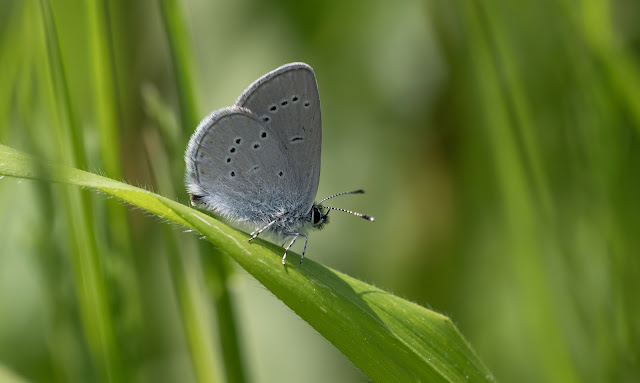As mentioned on an earlier post, my local patch suffered for a very long time, with the cooler easterly winds, so to find interest I was having to look at sites that were not so affected.
One of my walks took me to Friston Forest, where after a long walk I came across a very small brown/ orange moth flying low over Bluebells. After getting the binoculars on it I spotted that it wasn't alone, so I crept a little closer and, then spotted a 3rd moth. This one was clearly a female, keeping quiet and resting whilst the males tried to scent her out. Although not a particularly rare moth, I think it's the first time that I've come across the Barred Hook-tip.
Female Barred Hook-tip.
Back to the patch, and walking down Greenway Bank, I stumbled upon a mating pair of Adela reaumurella. This really shows the difference in the length of the antennae of the male and female.
Mating Adela reaumurella. Male on right.
At last in late April, we had some much warmer days, that brought out the local Green Hairstreaks. The first day I saw them, I was frustrated as they kept landing high up on the bushes, but the following day, I had another go at them, and after a little patience I found a couple staying lower on their chosen bushes as they surveyed their territories.
Male Green Hairstreak.
Male Green Hairstreak .
Although many insects were a little later than usual on the patch due to that breeze, there was the odd exception, and the main one of those was the lovely Lace Border. I managed to spot 3 before the end of April. An early record, and according to the county moth recorder, the earliest ever record for this species in Sussex.
An April record of Lace Border.
In early May, I do enjoy a river walk, searching early odonata and Mayflies. These delicate insects are always a thrill to find.
Mayfly. (Ethemera sp.)
Teneral Large Red Damselfly.
Back to the patch, and a beautiful larva that I only spotted due to a text coming through on the phone that stopped me in my tracks, and as I was checking the phone, my eye was caught by a strange shape, that turned out to be a Mottled Umber larva.
Mottled Umber larva.
It was also good to find a large number of Peacock larvae amongst the nettles. I guess more than one female Peacock had laid eggs there as the larvae were spread over a large area.
Peacock larvae.
A couple of weeks after my Green Hairstreak season started, I came across this one asleep on a cool cloudy day. Green Hairstreak normally roost deep in the foliage and are almost impossible to find, so it was a very pleasing find. It was also of the form where the 'streak' covers both wings.
Green Hairstreak. form punctata.
On May 16th, I was doing my annual 1st brood Wall Brown count, when I came across my first Norfolk Hawker of the year. I'm yet to find out where the Norfolk Hawker is breeding locally, but it must be somewhere in the Cuckmere valley. This is the 3rd year running that I've found a very early Norfolk Hawker close to High and Over. After watching it for a few minutes, as it hawked away, hunting prey, it finally settled on a Gorse bush. It wasn't in an ideal position, but by standing on tip-toe I just managed to get a few record shots of it. Further along the walk, I came across a 2nd Norfolk Hawker. This time along the valley, where I also saw a couple of Scarce Chasers.
Teneral Norfolk Hawker.
The following day, just before Lisa and I were heading to the Isle of Wight to look for the Glanville Fritillary, we went along the valley, hoping to see both the Norfolk Hawker, and the gorgeous Alabonia geoffrella micro moth. James had found this moth a few years ago, and since then, I've been lucky enough to see and photograph them several times. We did come across another, or the same Norfolk Hawker, that Lisa managed to photograph, and then onto the area for the geoffrella, where we successfully found 3 of these stunners. Unusually one of them stayed long enough for both of us to get a few images too.
Alabonia geoffrella.
During our walk we also saw our first Small Blue's of the year. I've always struggled to get decent photos for some reason, of these smallest of British butterflies, so it was nice to actually get a few shots that I was pleased with.
Small Blue.

















No comments:
Post a Comment